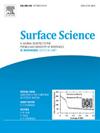The effect of Al component on the adsorption structure of doped precursors on the NH2covered AlxGa1-xN(0001) surfaces
IF 2.1
4区 化学
Q3 CHEMISTRY, PHYSICAL
引用次数: 0
Abstract
Using the first-principles pseudopotential plane wave method based on density functional theory, a detailed computational analysis of the adsorption structure of dopant precursors (Mg and Si atoms) on the NH2-covered AlxGa1-xN(0001) surface with different Al components was carried out. By analyzing the surface adsorption energy, partial wave density of states, and Mulliken population, the possible stable adsorption structures were determined. The research found that: for the NH2-covered AlxGa1-xN(0001) adsorption surface, all adsorption precursors have only T4 and H3 adsorption sites and the adsorption mechanism is independent of the surface Al composition. With the increase of the Al component in the adsorption surface, the bond energy weakens. The Ga-rich (0001) surface and the H3 adsorption site are more conducive to the adsorption growth of the precursor, and the higher or lower surface Al component is not conducive to adsorption growth; the NH2-covered AlxGa1-xN(0001) surface is conducive to n-type doping rather than p-type doping.
Al组分对掺杂前驱体在nh2覆盖AlxGa1-xN(0001)表面吸附结构的影响
采用基于密度泛函理论的第一性原理赝势平面波方法,对掺杂前驱体(Mg和Si原子)在不同Al组分的nh2覆盖AlxGa1-xN(0001)表面的吸附结构进行了详细的计算分析。通过分析表面吸附能、态的分波密度和Mulliken居群,确定了可能的稳定吸附结构。研究发现:对于nh2覆盖的AlxGa1-xN(0001)吸附表面,所有的吸附前驱体都只有T4和H3吸附位点,并且吸附机制与表面Al组成无关。随着吸附表面Al组分的增加,键能减弱。富ga(0001)表面和H3吸附位点更有利于前驱体的吸附生长,而表面Al组分较高或较低则不利于吸附生长;nh2覆盖的AlxGa1-xN(0001)表面有利于n型掺杂而非p型掺杂。
本文章由计算机程序翻译,如有差异,请以英文原文为准。
求助全文
约1分钟内获得全文
求助全文
来源期刊

Surface Science
化学-物理:凝聚态物理
CiteScore
3.30
自引率
5.30%
发文量
137
审稿时长
25 days
期刊介绍:
Surface Science is devoted to elucidating the fundamental aspects of chemistry and physics occurring at a wide range of surfaces and interfaces and to disseminating this knowledge fast. The journal welcomes a broad spectrum of topics, including but not limited to:
• model systems (e.g. in Ultra High Vacuum) under well-controlled reactive conditions
• nanoscale science and engineering, including manipulation of matter at the atomic/molecular scale and assembly phenomena
• reactivity of surfaces as related to various applied areas including heterogeneous catalysis, chemistry at electrified interfaces, and semiconductors functionalization
• phenomena at interfaces relevant to energy storage and conversion, and fuels production and utilization
• surface reactivity for environmental protection and pollution remediation
• interactions at surfaces of soft matter, including polymers and biomaterials.
Both experimental and theoretical work, including modeling, is within the scope of the journal. Work published in Surface Science reaches a wide readership, from chemistry and physics to biology and materials science and engineering, providing an excellent forum for cross-fertilization of ideas and broad dissemination of scientific discoveries.
 求助内容:
求助内容: 应助结果提醒方式:
应助结果提醒方式:


